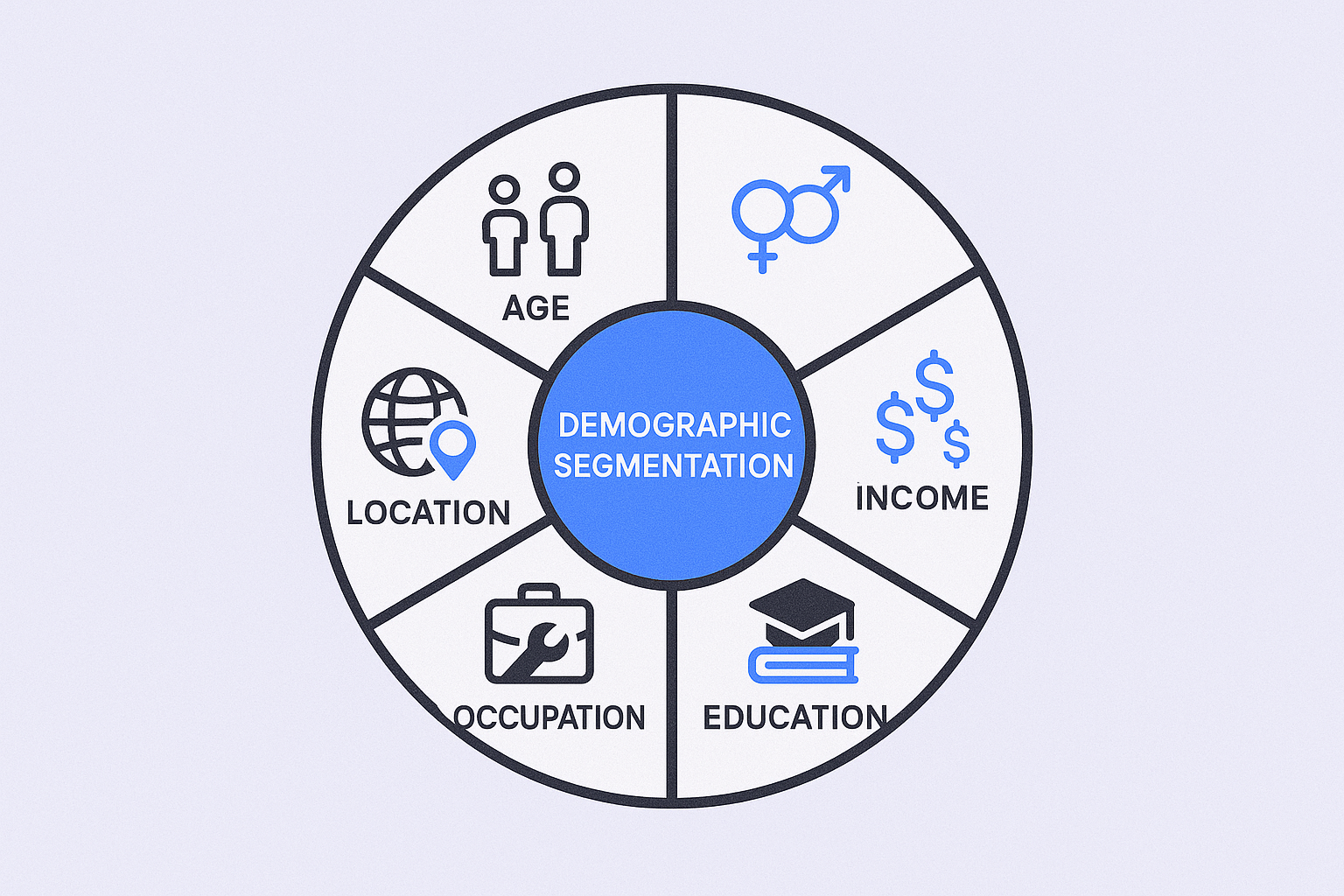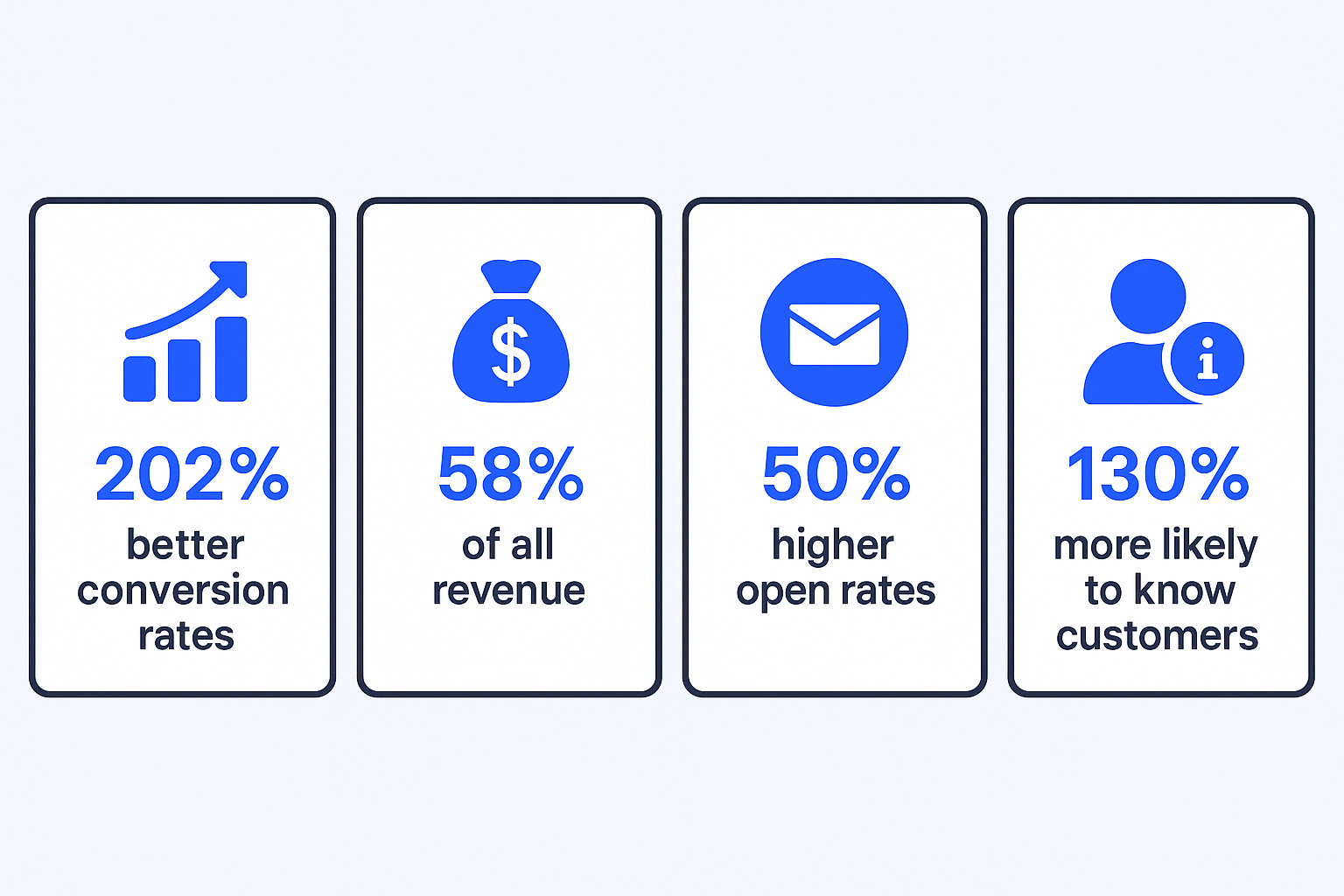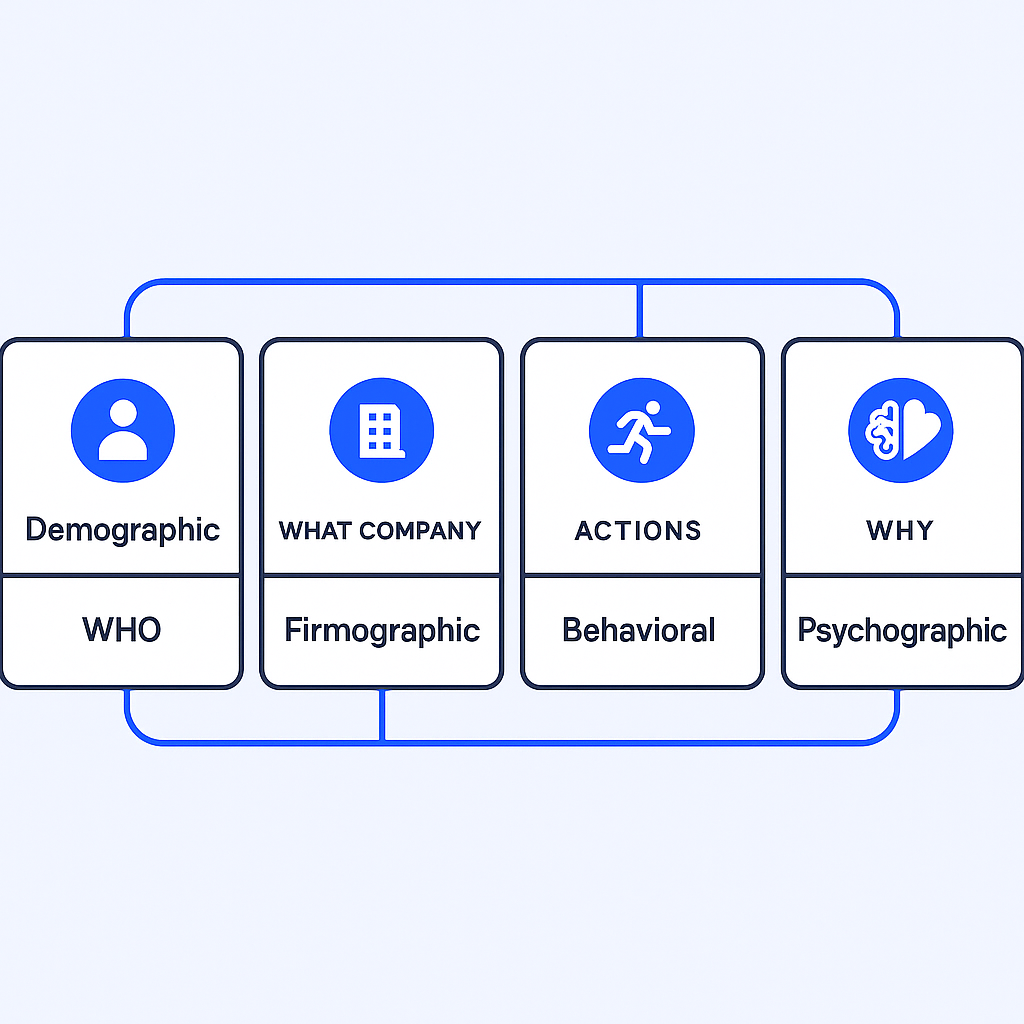- blog
- Lead Generation
- Why Demographic Segmentation Matters for Sales Success

Why Demographic Segmentation is Your Secret Weapon for Crushing Sales (and Boosting Revenue!)
Table of Contents
Introduction: Sales Professionals, Let’s Talk About Your Target Audience
The daily grind for sales professionals involves constant pressure to hit targets, generate quality leads, and close deals. Cutting through the noise in today’s competitive landscape is a significant challenge. Generic, one-size-fits-all outreach often falls flat, wasting valuable time and resources. This is where demographic segmentation emerges as a powerful, practical tool that directly impacts your daily prospecting and sales efforts.
Demographic segmentation helps brands target the right audience by grouping people based on age, income, education, and more. It’s a marketing strategy that involves dividing an audience into groups based on shared demographic traits such as gender, age, location, income, nationality, education, occupation, family status, and marital status. The goal is to empower sales professionals to quickly grasp this concept and make informed decisions that drive results.
Demographic Segmentation: What’s the Big Deal Anyway?
What it is: A Friendly Definition
Demographic segmentation involves understanding the makeup of an audience and drilling down to create distinct groups based on characteristics like age, location, socioeconomic background, and family situation. This approach uses markers that describe how different populations live and define themselves, providing a clear picture of who potential customers are. Essentially, it’s about grouping people based on shared, measurable traits such as age, gender, income, education, and family situation.
Why it matters for Sales: Direct Impact
Understanding these demographic data traits helps sales teams show the right messaging to the right people, ensuring customers receive more relevant communication. This allows businesses to target resources more effectively, leading to improved outcomes. Demographic segmentation is a fundamental market research tool that enables the creation of customer profiles, which in turn allows for more effective sales strategies, adding value to products and improving the bottom line.
For sales professionals, this foundational understanding is critical because it provides an initial layer of qualification by revealing who a prospect is on a fundamental level. This understanding of “who” a prospect is directly influences how they prefer to be communicated with, what their potential pain points might be, and how receptive they might be to a particular offer.
Variables for Demographic Segmentation
These variables serve as essential ingredients in a prospecting toolkit. Each offers a unique lens through which to view and understand the target audience, helping to craft messages that truly resonate.
Age: Speaking to Every Generation
Individuals within the same age group often share similar tastes, preferences, and lifestyles. Marketers typically group age into generations like Baby Boomers (1946–1964), Generation X (1965–1979), Millennials (1980–1994), and Generation Z (1995–2012). Those raised in the same period generally experienced similar cultural and societal shifts, leading to shared thought processes and characteristics.
For sales professionals, knowing a prospect’s age helps determine which social media platform to use for engagement and how to tailor cold emails. For instance, younger demographics (under 24) are more likely to use Snapchat and Instagram, while Twitter’s largest user group is between 18 and 29. LinkedIn, a key platform for B2B engagement, has a significant presence of younger to middle-aged users, with 50.6% of global users aged 25-34.
Different generations consume information and prefer communication channels differently. A Gen Z decision-maker might be more receptive to a short, engaging video message on a social platform, while an older executive might prefer a concise, direct email or phone call. By segmenting by age, sales professionals can select the most effective channel and content format for their outreach, significantly increasing the likelihood of engagement.
Nationality: Beyond Borders, Beyond Assumptions
Nationality and cultural background profoundly influence consumer preferences, behaviors, and even decision-making processes. For sales professionals engaged in global targeting, it’s essential to focus on local lead generation. This involves translating content, using culturally relevant visuals, and considering local time zones and holidays.
Cultural sensitivity is paramount for building trust and fostering strong business relationships. This means understanding diverse communication styles, avoiding jargon or idioms that don’t translate well, and encouraging feedback loops to confirm understanding.
Gender: Crafting Inclusive & Effective Messages
While traditionally binary, modern demographic segmentation marketing increasingly acknowledges non-binary and other gender identities. In business sales, the approach is evolving towards more consultative, relational, and long-term orientations.
The importance of this goes beyond simple product preferences. Understanding gender (and avoiding stereotypes) in business is about crafting inclusive communication that resonates with a diverse professional audience. Using gender-neutral language and emphasizing collaborative, consultative value propositions can appeal to a broader range of decision-makers, avoiding advertising gender stereotypes.
Income: Aligning Your Pitch with Their Wallet
Income levels directly influence purchasing power, spending habits, and priorities. High-income individuals might prefer luxury brands, while middle-income earners might prioritize value, and low-income customers may prioritize affordability and durability.
For sales professionals, this means targeting high-value prospects and tailoring value propositions to financial capacity. In business contexts, this translates to targeting companies by revenue or budget. Tailoring proposals, pricing strategies, and product tiers based on the prospect’s income level or company revenue helps prevent presenting luxury solutions to budget-constrained prospects.
Education: The Smart Way to Talk Shop
Educational attainment can significantly affect consumer interests, product choices, values, and how individuals consume information. For sales professionals, this variable guides the adjustment of pitch complexity and content. Individuals with higher education may prioritize certain product features or be more receptive to detailed, research-backed content.
Even within a technical audience, educational backgrounds and technical comfort levels can vary. Tailoring the technical depth and language of the sales pitch based on perceived educational background can significantly improve comprehension and engagement.
Occupation: Solving Their Daily Headaches
Occupation targeting classifies people by job title, industry, or a combination of both. Different occupations come with varied lifestyles, needs, and financial capacities. This is particularly useful for companies aiming to reach decision-makers or influencers.
Sales professionals can tailor messages to resonate with specific job titles and their associated pain points. Different roles have different KPIs, challenges, and priorities, even within the same company or industry. By segmenting by occupation, professionals can craft hyper-personalized outreach that speaks directly to the recipient’s daily challenges.
Family Status & Marital Status: Understanding Their Life Stage
These factors primarily influence purchasing decisions related to housing, automobiles, and family-oriented services. While less direct for business sales, understanding these factors can provide subtle insights into a prospect’s personal priorities and work-life balance.
🎯 Beyond Basic Demographics
LinkedIn outbound engine combines demographic targeting with proven frameworks for superior result
Demographic Segmentation: Why It’s Your Sales Superpower
Demographic segmentation is not just a good idea; it’s a necessity for sales professionals aiming to achieve sustainable growth. This section highlights the tangible, data-backed benefits that make it a sales superpower.
Boosts Personalization & Engagement
Tailored messages cut through the noise of generic outreach. When prospects feel understood, they are far more likely to engage. Personalized calls-to-action result in 202% better conversion rates than standard calls to action. Segmented and personalized emails generate 58% of all revenue. Furthermore, personalized emails have 50% higher open rates and higher click-through rates than non-segmented campaigns.
71% of consumers expect personalized interactions, and 76% express frustration when interactions are not personalized to their interests. The average inbox is flooded with generic messages, making it difficult to stand out. Personalization, driven by demographic data, creates a message that feels specifically crafted for the recipient.
Skyrockets Lead Quality & Conversion Rates
Focusing on demographically segmented audiences means directing sales efforts towards those with the highest propensity to buy. This precision ensures professionals spend their time on leads that are genuinely interested and capable of purchasing. Segmentation can achieve up to a 50% increase in conversion rate. Companies that personalize their web experiences see an average conversion rate increase of 80%.
Furthermore, companies that segment their customers are 130% more likely to know their customers’ motivations. Without segmentation, sales professionals might generate a high volume of leads, but many could be unqualified or a poor fit. Demographic segmentation allows for more accurate identification of Ideal Customer Profiles (ICP).
Optimizes Time & Resources (No More Wasted Efforts!)
Why waste time and money on broad, generic campaigns that may or may not work? Demographic segmentation enables the efficient allocation of budget, time, and resources by focusing only on the audience segments that matter most. Multi-channel marketing campaigns achieve a 31% lower average cost per lead than single-channel outreach.
By using demographic segmentation, sales professionals can focus their efforts on prospects most likely to respond, thereby reducing the cost per lead and per meeting. This efficiency translates into more productive outreach activities and less time spent on dead ends.
Builds Stronger Relationships & Loyalty
When customers feel understood and valued, they are more likely to remain loyal to a brand. Customized messaging fosters stronger, long-term relationships. 75% of consumers prioritize personalized communication when making purchasing decisions. An impressive 95% of marketers believe personalization improves customer relationships. Furthermore, email segmentation can lead to a 33% increase in customer lifetime value.
Gains a Competitive Edge
Brands that truly understand their audience stand out from the competition. Demographic segmentation provides an edge by allowing for more relevant, personalized, and engaging messaging than competitors. Companies with aligned sales and marketing teams are 67% better at closing deals. In fact, 80% of companies that use segmentation models report a boost in sales.
Examples Of Segmentation Based On Demographics
This section illustrates how demographic segmentation plays out in real-world scenarios, with practical applications relevant to sales professionals.
Segmentation By Age
While age segmentation is often seen in consumer contexts, its influence in business primarily revolves around communication channels and content preferences. For example, a tech company launching a new collaboration tool might target younger professionals (Millennials, Generation Z) on platforms like LinkedIn and social media where these groups are highly active, using visually dynamic content such as short videos or infographics.
Conversely, when targeting the 35-44-year-old demographic, who are often in key decision-making roles, the approach shifts. This group values quality, convenience, and authenticity. They engage effectively with long-form, informative content like webinars, detailed blog posts, and educational videos.
Gender Segmentation
While avoiding advertising gender stereotypes is paramount, business messaging can subtly adapt to promote inclusivity. Studies show that gender-diverse sales teams are linked to higher sales quota attainment and customer satisfaction. This suggests that an internal understanding of gender dynamics can influence the external sales approach.
Modern consumers and business buyers increasingly value inclusivity and authenticity from brands. By consciously adopting gender-inclusive language and avoiding stereotypes in sales communication, professionals not only act ethically but also align with the values of progressive companies and decision-makers.
Segmentation By Family Status
Family status is primarily a consumer demographic, influencing purchasing decisions for items like family cars or baby products. However, business buyers are individuals with personal lives, and this can indirectly influence their professional interactions.
For instance, a SaaS company selling productivity tools might subtly highlight how their solution helps busy professionals achieve better work-life balance or save time, thereby aligning with their personal priorities.
Segmentation Based On Income
In a business context, income segmentation translates to targeting companies based on their revenue, budget, or purchasing power. For example, a software provider might offer enterprise-level solutions to high-revenue corporations (Fortune 500 companies) and more affordable, streamlined versions to startups or small-to-medium businesses.
Amazon segments companies by size (often correlated with revenue) to offer different solutions, from AWS Free Tier cloud computing services for small firms to customized cloud infrastructure for large corporations.
The most effective sales and marketing strategies combine demographic segmentation, firmographic, behavioral, and psychographic data. This creates a comprehensive view of the prospect, enabling truly hyper-personalized and timely outreach.
🚀 Advanced LinkedIn Targeting
Strategic demographic segmentation delivers personalized campaigns with systematic scaling approaches
7-day Free Trial |No Credit Card Needed.
Wrap Up: Your Path to Sales Success Starts Here
Demographic segmentation is not merely a marketing concept; it’s a practical, powerful tool for sales professionals. It’s about understanding the target audience on a deeper level to make every outreach count. This approach leads to hyper-personalization, higher lead quality, increased conversions, optimized resources, and a significant competitive edge.
In today’s data-driven world, generic approaches are obsolete. Embracing segmentation is essential for any sales professional looking to achieve sustainable growth and stay ahead. Having accurate demographic data and the right tools (such as a cold email platform that facilitates personalized outreach) is key to unlocking these benefits.
Start implementing these strategies in cold email and multi-channel outreach immediately to see real results. The statistics speak for themselves: companies using segmentation see up to 50% increases in conversion rates, and personalized campaigns generate 122% higher ROI. The question isn’t whether you can afford to implement demographic segmentation—it’s whether you can afford not to.
FAQs
Do Demographics Matter?
Yes, absolutely! Demographics are fundamental. They provide the basic framework for understanding who an audience is (age, gender, income, etc.). This foundational knowledge allows sales professionals to tailor messaging, choose the right channels, and make outreach far more relevant and effective.
Demographics provide the essential, easily quantifiable “who” that forms the base layer upon which other data points gain context. They are the non-negotiable starting point for any effective segmentation strategy.
How To Use Demographics For Your Segmentation Study?
To use demographics for a segmentation study, start by defining your objectives. Then, collect demographic data from existing customers through surveys, questionnaires, or by analyzing existing customer data. Identify key demographic variables relevant to your product or service (e.g., age gender for social media platform choice, income for product pricing).
Create customer segments based on these variables, develop personalized messages for each, and continuously test and optimize your strategy. The process is iterative: initial segmentation provides a hypothesis, and testing provides feedback for continuous refinement.
Where To Find Demographic Segmentation Data?
Demographic data can be found from various sources:
- Internal market research: Surveys and questionnaires to current customers
- Government data: Census data provides extensive information about populations
- Market research firms: Purchase data or reports from specialized firms
- Social media and online analytics: Tools like Google Analytics or LinkedIn Insights provide demographic data of users
- Data enrichment platforms: Tools that provide demographic, firmographic, and technographic details for prospects
Combining internal data with external data providers creates a robust “data stack” ensuring comprehensive and verified demographic data.
What Is A Demographic Example?
A demographic example is a specific group defined by shared characteristics. For instance:
- Age: “Young professionals (ages 25-35) interested in high-intensity workouts”
- Income: “High-income professionals in their 40s who are interested in luxury cars”
- Occupation: “IT managers or CTOs who have the power to approve software purchases”
- Combined: “College-educated single women most likely to try your product”
These examples help make abstract concepts concrete and translate directly into buyer personas that can be visualized and targeted.
Is Demographic Segmentation Right For Me?
If you’re looking to improve outreach, qualify leads more efficiently, boost conversion rates, and work smarter, then yes, demographic segmentation is absolutely right for you. It’s a foundational strategy that enables personalization, reduces wasted effort, and helps build stronger relationships with prospects, ultimately leading to achieve sustainable growth in your sales pipeline.
The statistics demonstrate how demographic segmentation directly impacts key sales metrics such as engagement, conversion, and efficiency. It’s not a niche strategy but a universally beneficial one for anyone in sales, making it an essential tool for success in today’s competitive landscape.

Segmentation That Actually Converts
LinkedIn outbound targets precise demographics with strategic campaign design and scaling methods
